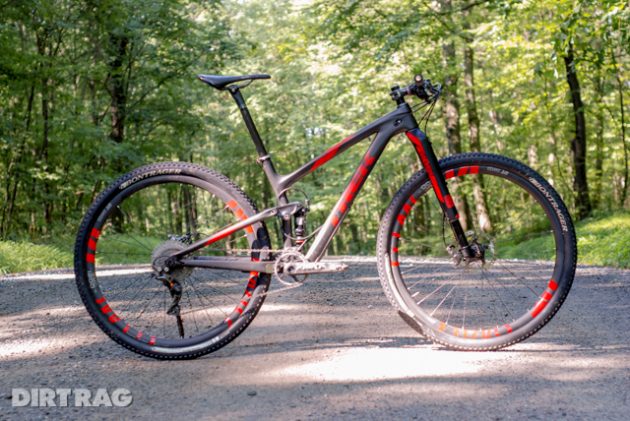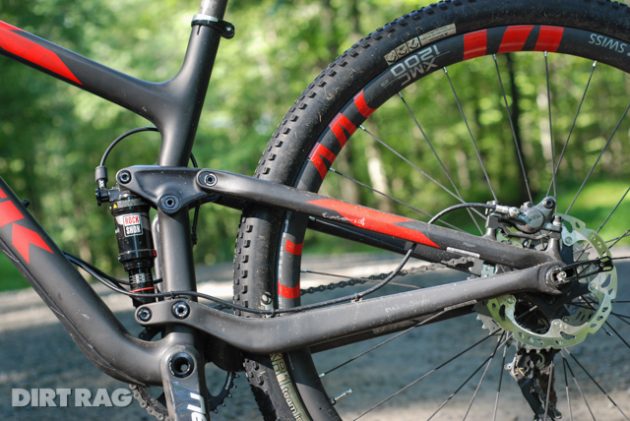Review: Trek Top Fuel 9.9 SL
Originally posted on January 25, 2016 at 11:21 amTester: Mike Cushionbury | Age: 45 | Height: 5’10″ | Weight: 155 lbs. | Inseam: 32”
Trek discontinued its 26-inch-wheeled Top Fuel cross-country line a few years back in favor of the successful Gary Fisher 29er Superfly FS. Now, as the Superfly grows long in the tooth, the Top Fuel is reborn for 2016. And it’s as modern and high-tech as a cross-country bike can be.

The frame is entirely carbon and, like the longer-travel Fuel EX, the 100 mm travel Top Fuel uses an EVO rocker link and Full Floater suspension design, which attaches the shock to two moving points. It also has Active Braking Pivot and the geometry-adjusting Mino Link. This changes head-tube angle by half a degree and raises or lowers the bottom bracket by 8 mm, going from a 70-degree head angle and 12.9- inch bottom bracket in low to 70.9 degrees and 13.4 inches in high. This brings the short-stravel bike in line with the technology Trek has been using for its long-travel bikes, raising the expectations of what a cross country bike is capable of.
The Top Fuel has Boost 148/110 hub spacing, Smart Wheel Size and Control Freak cable management. Boost, which was developed in part by Trek last year for its trail and all-mountain bikes, creates a stronger 29er wheel and frame. Boost also provides more tire clearance and gives Trek the opportunity to shorten the chainstays by 17 mm compared to the Superfly. With 148—which is as wide as you can go without affecting Q factor—width and bottom-bracket junction stiffness is maximized without making the bike wider at the cranks. By going 110 on the fork, the front end is equal to the rear in terms of strength, stability and the ability to run a bigger tire.

Trek believes that for cross-country applications a 29er wheel is absolutely the fastest, so you won’t be seeing multiple options; it’s 29 only, save for the 15.5-inch frame. Smart Wheel Sizing dictates that for this small of a frame, 27.5 is the answer to keep the bike fitting correctly, lower the front end and achieve no wheel/toe overlap. Frame sizes 17.5 inches and larger utilize 29-inch wheels.
Believe it or not, with all the various drivetrain, suspension and dropper-post options, there are 54 different ways to route cables, according to Trek. To make sure any and all work, Trek developed a very flexible system called Control Freak cable management that works with any combination of cables and electronic wires, including internally routed dropper posts. There are also small guides along the down tube and top tube to cleanly run your rear brake or dropper post externally if you choose.

Interestingly, Trek didn’t include a specific bottom-bracket or seat-tube internal option for a Shimano Di2 electronic battery; it’s meant to run sidesaddle to the water-bottle cage or for you to use a cable cinch in the down tube, meaning you’d have to take the fork out of the head tube and then lower the battery into the down tube from there. Also, the bottom bracket access port for internal cable installation is on the small side compared to other brands, making access a bit more challenging.
At a price of nine grand, the line-leading Top Fuel 9.9 SL has a complete package of top-shelf parts, albeit some surprising yet sound choices that stray from what you might expect. Shifting is handled by
the flawless Shimano XTR cable system, yet rather than a traditional Shimano double ring, the 9.9 SL goes 1×11 with Race Face’s ultralight Next carbon crank and direct-mount 32T chainring. And while accessories like the handlebar, seatpost, stem and saddle are all feathery Bontrager XXX carbon fiber, Trek felt that stiff, yet light, DT Swiss XMC 1200 carbon wheels were the best choice to match up with its Boost spacing. Suspension is controlled by a RockShox RS-1 Solo Air fork and Monarch XX shock with an XLoc Full Sprint hydraulic remote lockout that controls both the shock and fork.
All this adds up to a 29er full-suspension race bike that weighs less than 22 pounds. Trek claims a 17.5 inch frame with shock and all hardware weighs only 4.3 pounds.

I kept the bike at the lower geometry setting to get the slackest head angle possible, in line with what most modern-day cross-country bikes are using. This, along with the added efficiency and stability
from the wider Boost spacing, makes the Top Fuel an extremely capable cross-country racer as well as an exceptional do-it-all endurance machine within the realm of 100 mm travel. It’s fast, it’s light and it handles like a dream.
Besides handling and climbing prowess, the wider stance, along with the EVO rocker link and Full Floater suspension, makes you forget, more often than not, that it has only 100 mm of travel. Oddly, within the first week of riding, the RockShox Full Sprint hydraulic remote button fell off, nullifying the ability to lock out the rear shock (the fork lockout remained operational), and I never missed it. Trek’s suspension design produced efficient pedaling even on the smoothest of climbs. If given an option, I’d easily choose a manual lockout for the shock rather than the hydraulic combination controlling both the shock and fork, since I didn’t necessarily need one for the shock.
Another surprise? While the stock Bontrager XR1 Team Issue tires looked questionable for rough, rocky conditions, set up tubeless they performed exceptionally well, providing great traction in all conditions (I could successfully run less than 20 psi when it was wet and slick). They have also proven to be very durable.
With Boost spacing, a PF92 bottom bracket and hydraulic linked suspension, there’s very little part swapping to be had with the Trek Top Fuel 9.9 SL. When you consider the quality of all those parts, there’s nothing I’d change besides having the option for a manual-lockout shock.
The Top Fuel is one of the most high-tech, potent and fun short travel 29ers I’ve ever ridden; it’s also one of the lightest. It’s a full-on racer as well as a full-on fun-to-ride bike. There is one other thing I’d change, though: adding my own dropper seatpost. This little addition would help make the Top Fuel an even more aggressively awesome bike on the descents.
- Wheelbase: 43.7″, 53.6
- Top Tube: 23.8″
- Head Angle: 70°, 70.9°
- Seat-Tube Angle: 74º, 74.9
- Bottom Bracket: 12.9″, 13.4″
- Rear Center: 17″
- Weight: 21.3 lbs. w/o pedals
- Price: $9,000
- Sizes: 15.5″, 17.5″ (tested), 18.5″, 19.5″, 21.5″ (specs based on size tested)
- Online: trekbikes.com